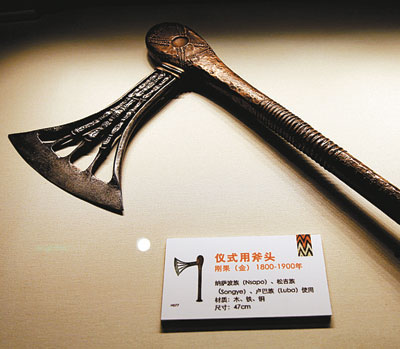|

Cao Zhen
caozhen0806@126.com
A LARGE collection of Central African weapons is on exhibit at the Shenzhen Museum in Civic Center, displaying the aesthetic qualities of the century-old weapons that were actually used for many functions.
Provided by Central African weapon experts and collectors Marc Leo Felix and Jan Elsen, the 360 exhibits include arrows, daggers, swords, sticks, knives, spears, axes and shields made from iron in the 18th to 20th centuries. They range from simple designs to those that are more refined and elaborately decorated.
“‘Fatal beauty’ is a good way to describe the traditional weapons in Central Africa because they are lethal and have the power to take a life with a single blow,” said Felix at the opening of the exhibition. “At the same time, from an aesthetic point of view, the weapons are known as works of art. They were made with exquisite workmanship. The beautiful lines and peculiar shape of the blades are extremely creative and imaginative, also full of mystery.”
It is without question that the exhibited African tribal weapons are diverse and skillfully crafted. This is evident in the hundreds of shapes of throwing knives, the main weapon for long-distance targets. The most seen shapes are bird beaks or sickles. Some knife blades are decorated with engravings and slits. Apart from being used as weapons, these decorated knives are ritual objects used to worship the ancestors of the tribe.
Another form of tribal African weapon is the shield, which also displays great variety. The simplest shields were made of tightly woven basketwork and decorated with painted designs. Some tribes made oval-shaped shields painted with geometric patterns for decoration. These shields are considered true works of art because of the level of artisanship used to make them.
According to Felix, the sophisticatedly designed weapons determined whether a warrior would win and survive in a fight. Hence, African blacksmiths kept improving the weapons’ shapes. In order to produce sharper and stronger blades, the furnace workers continuously improved smelting technology to extract light metals with excellent ductility.
One of the most fascinating things about the weapons is the fact that they were made not only for combat and hunting, but also for ceremonial activities and were used as currency. Felix said that before being used, the weapons were blessed in various ritual ceremonies. In some cases, items believed to have magical powers were put in the handles and grips of various weapons to protect the warriors in times of battle and to increase their chances of victory. Some weapons might be used for major purchases of land or animals or to signify a transfer of wealth at major events, such as a birth, coming of age, marriage, or death. The most frequent use was as part of a bride price, to compensate a family for the loss of a daughter in marriage.
With a large number of European explorers and colonists traveling to Africa at the end of the 19th century, gunpowder and firearms were traded in Africa in exchange for slaves, gold and ivory. Traditional African weapons were gradually replaced by firearms and were collected as art by Westerners.
Dates: Through May 28
Hours: 10 a.m.-6 p.m. Closed Mondays
Venue: Shenzhen Museum, Block A, Civic Center, Futian District (福田区市民中心A区深圳博物馆新馆)
Metro: Shekou or Longhua Line, Civic Center Station (市民中心站), Exit B
|

